
by TCW | Sep 10, 2019 | Book review
Marilyn Todd’s Snap Shot is described as a Victorian mystery. The thing about the Victorian period is that it really is very long. I was, at first, confused by the box Brownie cameras and the telephones, and a general feeling that we were, perhaps, more in Edwardian than Victorian times. The answer is that we are in a Victorian mystery, but only just. No date is given in the book, but the arrival of the box Brownie pins it down as about 1900.
1900 is a little outside my era: I’m more of a mid-nineteenth century writer myself, but Todd does seem to have a strong sense of period, although occasional intrusions by an authorial voice from the 20th or 21st century can be off-putting. When we are told of one character that “the V-sign he flashed wasn’t for victory” we are firmly in the Second World War or after. A phone might have “rung off the hook” in 1900, but it’s very unlikely – it’s definitely an idiom from the second half of the 20th century and while women nowadays may often complain of being “objectified” this isn’t a term that was much used in the period the book is set. Todd never puts these phrases in the mouths of her characters, but she would be better off avoiding them altogether. On the other hand, she often captures the period with beautiful images that gives a sense of the times without beating us around the head with “period detail” to prove how carefully it was researched (though it clearly was researched very carefully). Take this example, when a character takes a cab ride:
He could walk. It was only a mile. But there was something calming about the rocking of the hansom. The rhythmic clop-clop-clop of horseshoe against cobble. The smell of freshly polished leather.
Todd writes very well, with a lovely use of unlikely metaphors.
On the table, bluebells from the Common threatened to wilt but so far hadn’t plucked up the courage.
Or, of a restless man, our heroine watched him “dart about like a wasp with the runs”.
Ah, yes, our heroine. The story is told mainly from her point of view and, fortunately, she is a sympathetic character – a woman making her way in a man’s world. The difficulties put in the way of women in 1900 are spelt out but gently woven into the story. For example, it was legally difficult for a woman to run her own business.
Timbered Tudor buildings overhung the cobbles, rickety and narrow, with signs above the shops creaking in the wind. David Hart & Sons Pharmaceuticals, est 1823. Js. Simpson, Family Butcher. Thos. Payne, Barber. You could be forgiven for wondering if women actually existed.
Even to rent rooms for her work, she needed to find a man to vouch for her.
… Oliver, of course, signing the paperwork, women being too weak and too stupid to manage such matters themselves.
Julia McAllister, though, is not to be put off by these obstacles. She is gutsy, beautiful and, for 1900 has a very open mind – but as a photographer of dirty postcards, this is definitely a good thing.
Somebody is murdering Julia’s models and trying to frame her for it. Julia needs to find out who the real murderer is before the dangerously handsome Detective Inspector Collingwood arrests her.
The plot bowls along with plenty of gruesome deaths and a little bit of sex to keep the pages turning. Finding out whodunnit came as a surprise, but not so much of a surprise as to make me feel cheated. Thinking about it, there may have been the odd tiny gap in the plot, but far less than in the average TV detective story and, really, who is going to give it quite that much attention? It’s frothy and it’s fun and it has a convincing historical background. By the end, Julia is ready to leave the country, but I rather suspect she won’t. This book is set up for a run of sequels and I look forward to reading them.

by TCW | Sep 6, 2019 | Uncategorized
This summer we have been tourists in our own city. We bought a season ticket to the historic royal palaces and worked our way through them. Most (though not all) were places we had visited before, but it was lovely to go back, often after many years. We are lucky in London to have so many fabulous old buildings – despite this the Fire of London and the Blitz.
Last week’s blog was long and had no pictures. Unsurprisingly, not that many people tackled the 4,000 words (though if you are interested in seeing how Britain has been shaped by war, revolution and riot as much as by parliamentary debate, it’s worth a look). This week, by contrast, is going to be mainly about pictures as I share some of the photos we took over our tourist summer.
Tower of London
I was very privileged to be a guest of the Yeomen Warders to see the Ceremony of the Keys, when the Tower is locked up for the night. Sadly, I wasn’t allowed to take photographs during the ceremony but here is a picture of the White Tower (the oldest part of the castle) taken on another visit.
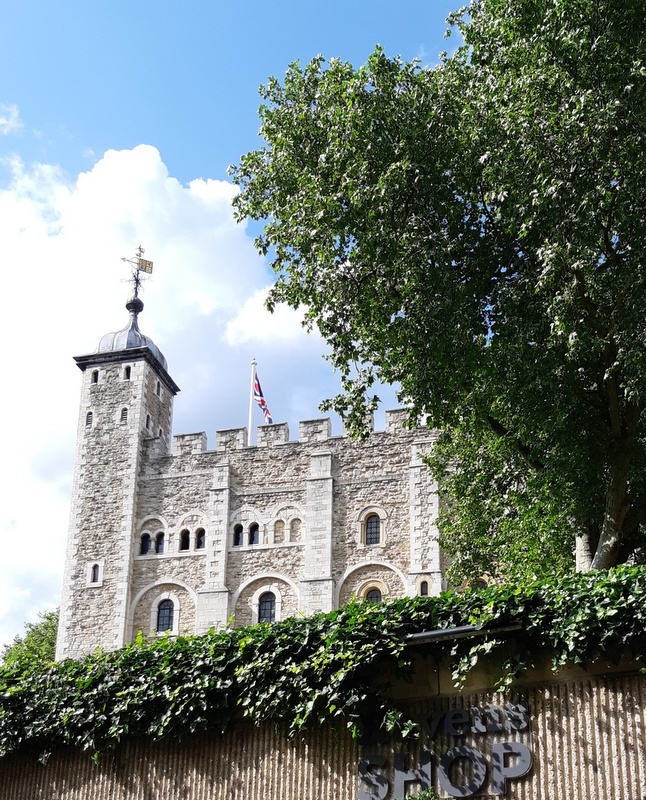
And here is one of the corridors in that tower.
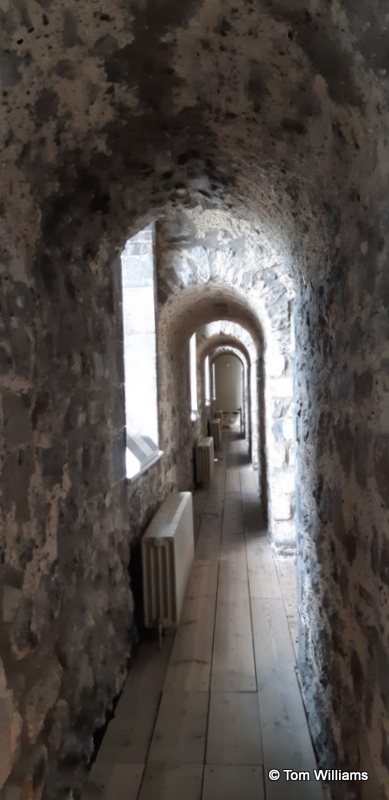
One of the things I love about the Tower is just how much you have the sense of being inside a great castle – almost like in the movies. Actually, though the fortress is real enough, many of the towers on the inner walls were demolished as the building was adapted to different uses across the centuries. A lot of the ones we see now were rebuilt in the 19th century when Wellington was the constable of the tower and made sweeping changes to restore it to something approaching its original appearance.
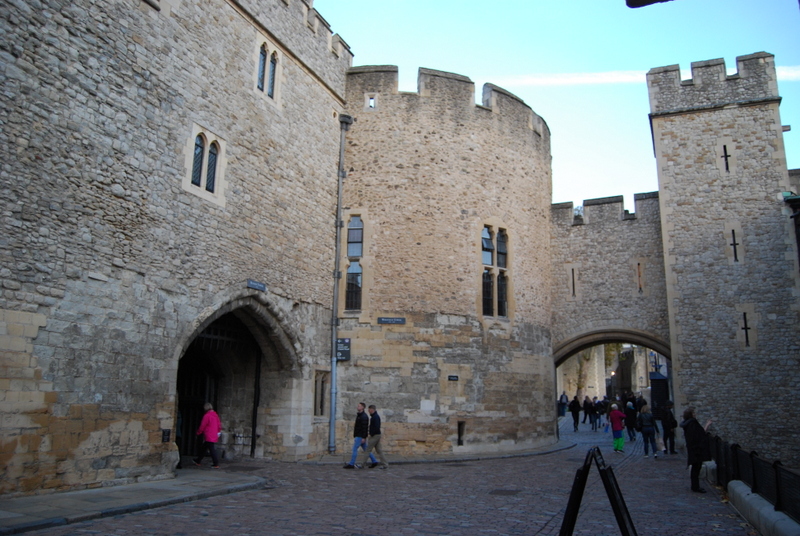
A great things about going to the Ceremony of the Keys was getting to see inside the Tower at night. It’s spectacularly atmospheric but, again, opportunities to take photographs were very limited so I’m afraid this is all I can offer.
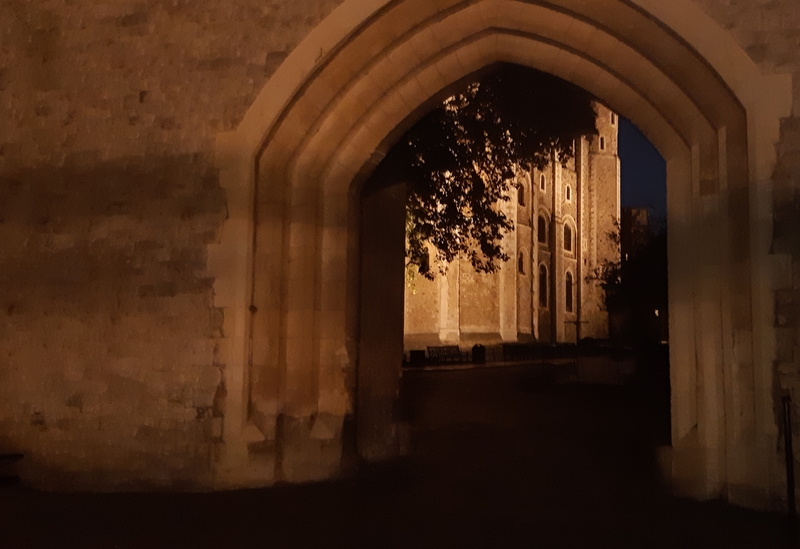
Kensington Palace
From outside, Kensington Palace looks like a dull brick building. The view out into Kensington Gardens is much more impressive than the view from the gardens toward the house.
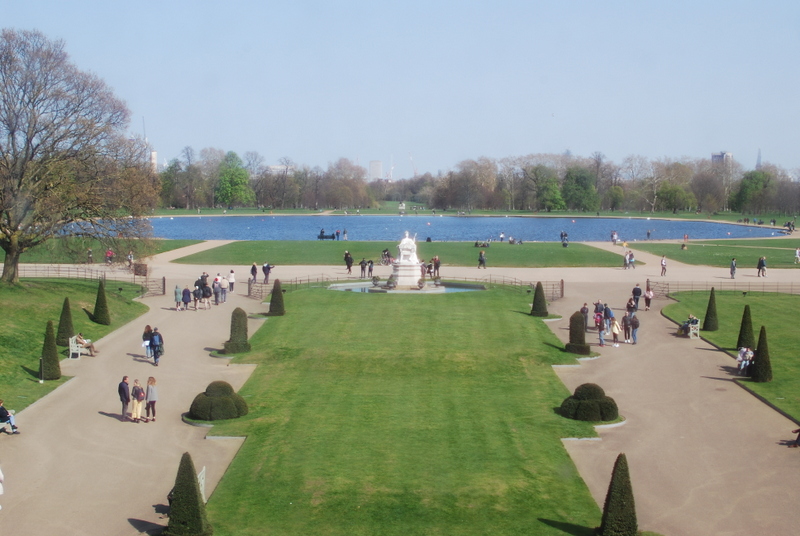
Inside, though, the building is fascinating. Like almost all these old palaces (the Tower of London is a really good example) it has grown over the years. Kensington Palace was once a small suburban villa called Nottingham House. King William (of William and Mary) was asthmatic and wanted to move away from the smoke of Whitehall to what was then the rural retreat of Kensington. He bought Nottingham House and, with the aid of Christopher Wren, set about turning it into a palace, moving in in 1689. Since then it has been continually added to and (unlike the other royal palaces we visited this summer) it is still a royal residence. It’s so big that Prince William and his family have their home in one of the wings at the back, well away from the bits that are open to tourists.
There are some very beautiful rooms. This is the King’s Gallery. Dating from 1695, it is where William, recovering from a riding accident, caught a chill (supposedly from sitting at an open window) which led to his death in 1702.
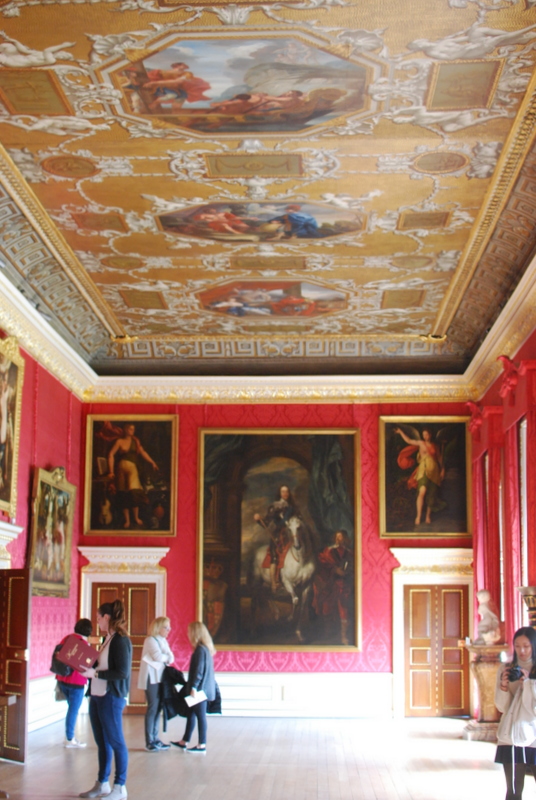
The ceilings at Kensington are particularly spectacular.
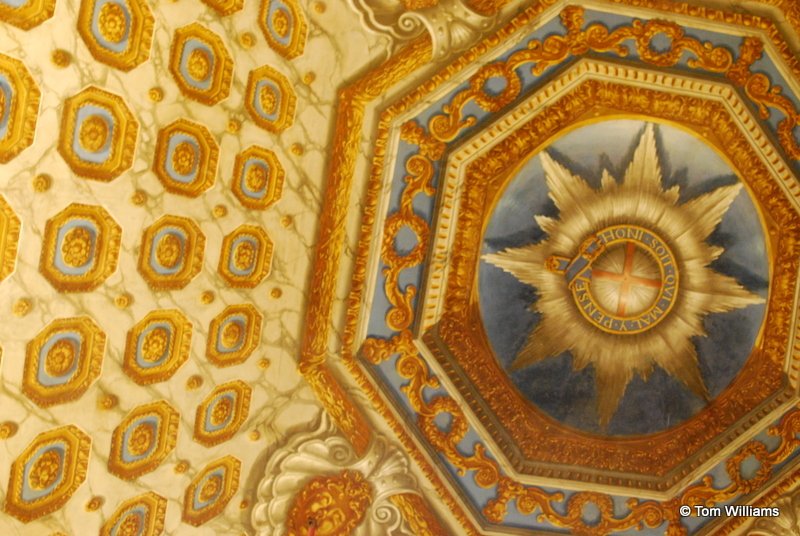
The King’s Staircase provides an amazing entrance to the early 18th century Georgian part of the palace.
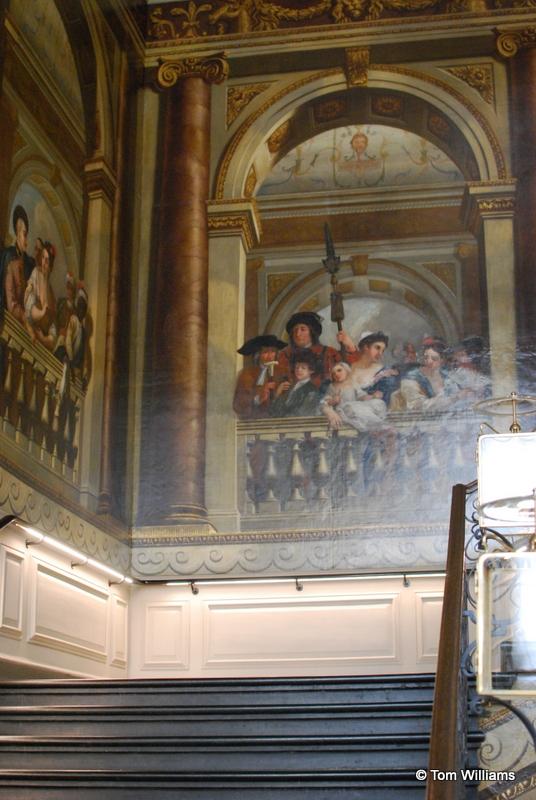
The walls are painted with pictures of actual people who lived and worked there.
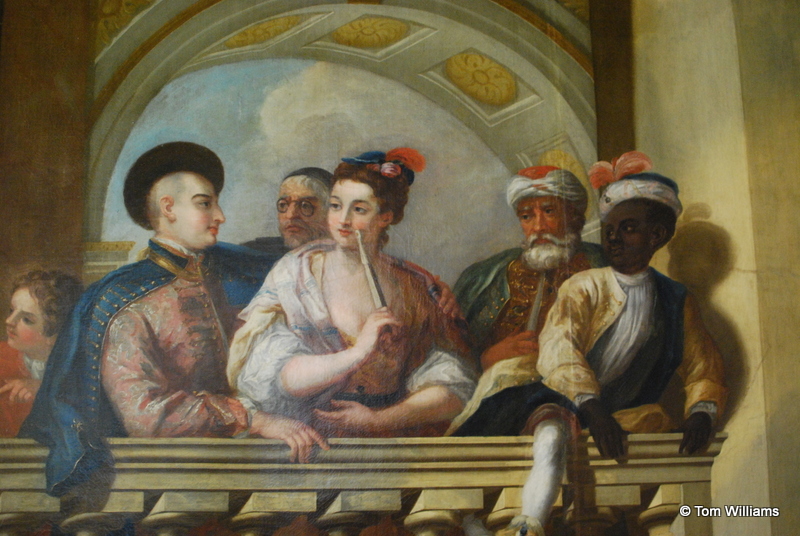
For many people, especially this year on the 200th anniversary of her birth, Kensington Palace is particularly important as the childhood home of Queen Victoria. The room where she was born has been restored and furnished to give some idea what it was like at the time.
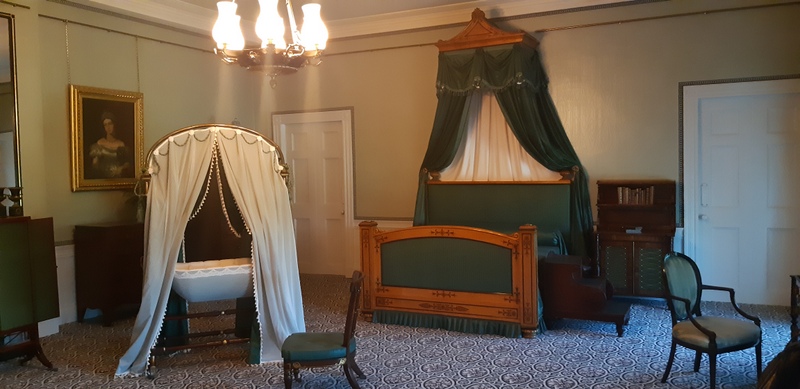
Hampton Court
Hampton Court Palace is huge. Essentially, there are two palaces: the famous Tudor palace of Henry VIII and an almost completely separate building built for William and Mary in the late 17th century.
Here’s the Tudor Great Hall.

The ceiling is amazing.
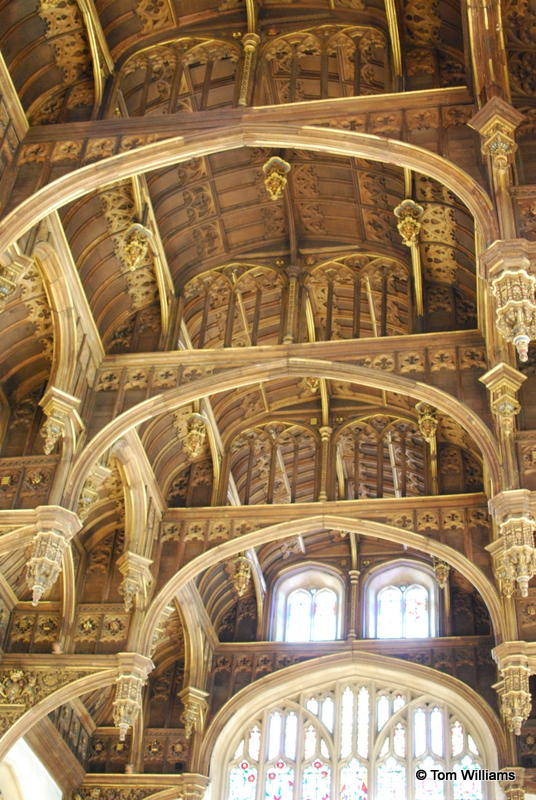
This is one of the state rooms in the ‘modern’ (William and Mary) part of the palace.
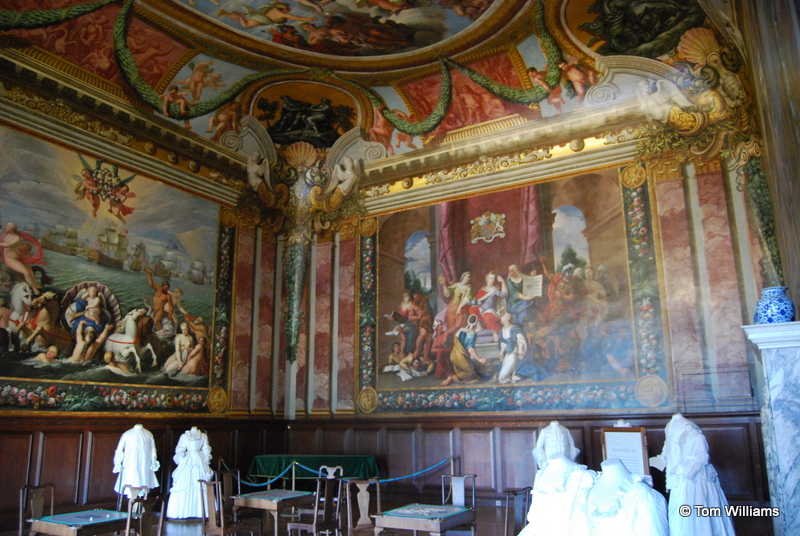
It’s equally splendid, albeit in a very different way.
Hampton Court is surrounded by gardens. We visited on one of the ridiculously hot days that we had this summer but the gardens, next to the Thames and with a long canal designed as a decorative feature, were surprisingly cool and pleasant.
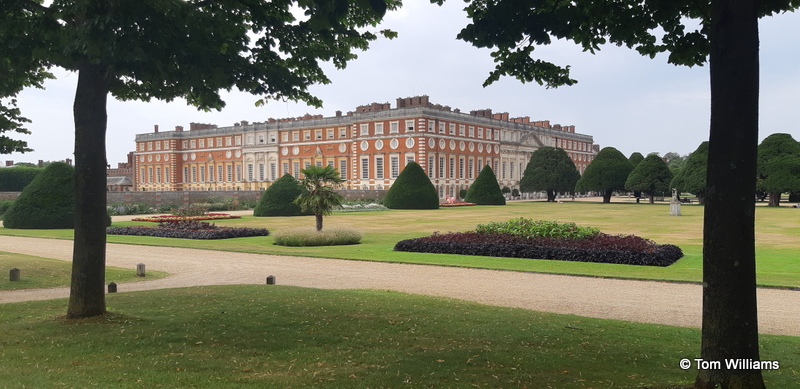
The gardens are historically important in their own right but, by the nature of gardens, they have changed a lot over the centuries. The grand Privy Garden, though, has recently been lovingly restored to close to its 18th century appearance.
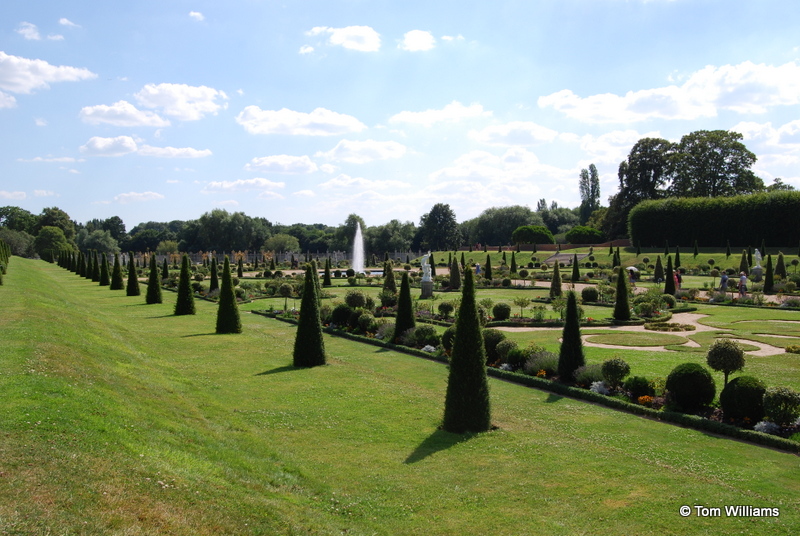
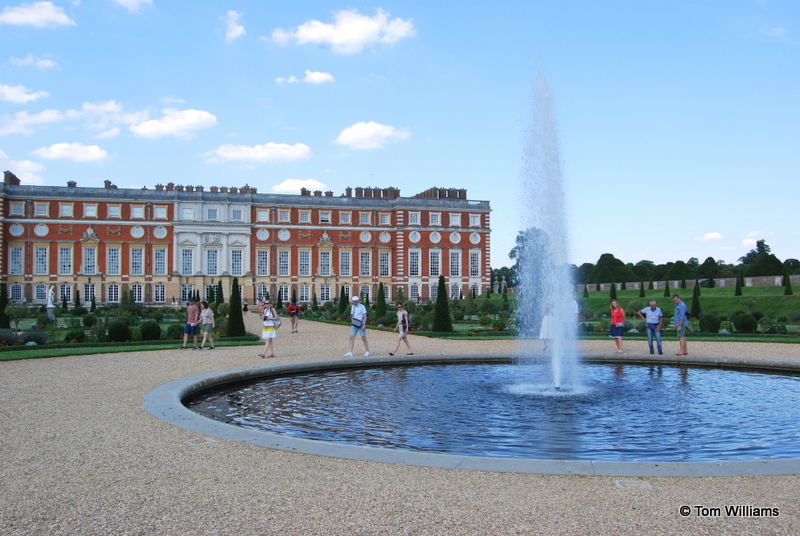
A word from our sponsor
That’s enough of my holiday snaps for one week. I’ll be back again next week. I post something on this blog a little over once a week on average, but I don’t make a penny out of it. If you enjoy reading the blog, the only thing I ask is that you buy one or more of my books. The cheapest of my books on Kindle costs just 99p. There is information on all my books, with buy links, on this website: http://tomwilliamsauthor.co.uk/my-books/
Alternatively, can I suggest that you look at the ‘Buy me a coffee‘ button and consider a donation? Ironically, the app doesn’t take donations as low as 99p and you don’t even get a book out of it, but I suspect that some people might find the idea of a straightforward donation easier than buying a book they may never read.
Thank you.

by TCW | Sep 3, 2019 | Book review
The Cabin is Jørn Lier Horst’s sequel to The Katharina Code, which I enjoyed so much that Penguin offered me an ARC of this latest one.
All the main characters from The Katharina Code are here: William Wisting, the police officer who led the last investigation; his journalist daughter, Line; the policeman from the Cold Squad, Stiller, with his unorthodox approach to obtaining confessions. Where The Katharina Code was, above all, a psychological thriller, The Cabin is more a regular police procedural, though the investigation Wisting leads is operating outside the normal police framework. He is investigating a crime that may involve a senior politician and the Director General of Public Prosecution, who can apparently instruct police how to proceed (we’re in Norway), is anxious that the investigation is conducted secretly.
Wisting runs the job from his own home, recruiting his daughter to interview suspects in the guise of her investigative journalism role. (Do they not have journalistic ethics in Norway?) The team work through suspects methodically, checking fingerprints, establishing alibis, researching links between criminals on the police intelligence database. Line asks questions the police cannot ask and gets an inside track on the links between the criminals, inevitably (it’s that kind of story) exposing herself to danger as the crooks realise she is working with the police.
The plot becomes fairly convoluted with an unsolved murder, a major robbery, an apparently accidental death of a suspect and various gang-related beatings all seemingly inter-related. Only at the end do we discover, thanks to an anonymous tip-off, what part the politician played in it all.
I’m being deliberately vague because of spoilers. It’s wanting to know how the crime works out that keeps you going. It’s not the characterisation: the police team are interesting, but this story adds nothing to the understanding of these people we gained in The Katharina Code
In the end, as in The Katharina Code, the psychology of the criminal is important, but this is only discussed after the crimes are all neatly solved. I suspect that Horst saw this as the core of the book, but the need to satisfy the story arc of a police procedural means it is rushed out as a coda at the very end of the story.
The Cabin is a perfectly serviceable detective mystery (though not helped by occasionally clumsy translation) but readers who loved the quirkiness of The Katharina Code may well feel disappointed.
The Cabin is available on Kindle (https://www.amazon.co.uk/Cabin-Cold-Case-Quartet-Book-ebook/dp/B07MM2QJMB). The paperback will be published on 12 December.
by TCW | Aug 29, 2019 | Uncategorized
As the country lurches its way through what most people seem to accept is a growing constitutional crisis, we reassure ourselves that it will all come right in the end because, after all, Britain has a history of political stability.
Only, like so many things we love to believe about Britain, this complacent statement has no real basis in fact.
What does history say about political stability in the past? Let’s look back to the history of the country since England and Scotland were united under one monarch, James I of England and VI of Scotland in 1603.
Civil War
It’s fair to say that James’ rule did mark a period of political stability, but he was followed by Charles I. That brings us to the little matter of the Civil War, which is about as unstable as you can get. The level of killing and economic disruption is almost incomprehensible nowadays. Four per cent of the entire population of England died during the war – probably nearer to 10% of the young men essential to an economy that was still largely agricultural. The casualty rate in Ireland was substantially higher: the exact level is still the subject of controversy.
Ireland, of course, brings a whole new level of political instability into the Union. Historically, the problems with Ireland probably go back even further, but Cromwell’s vicious suppression of Irish revolt started a train of events that were to have repercussions right to the present day. We’re working chronologically, but we will certainly come back to Ireland.
The Glorious Revolution
Cromwell’s rule ended in 1658 and by 1660 the Stuarts were back with Charles II on the throne. Although divisions remained in the country after the Civil War, Charles’ rule was accepted by those who did not want to see a resumption of violence. On his death, though, James II opened the old religious rivalries by being seen as favouring the Catholic cause. The result was the Glorious Revolution. William of Orange was invited to take over the throne with his wife, Mary. That’s the way that it’s usually represented, but it wasn’t quite as smooth as that. William had been planning to invade Britain before he was “invited”. He wanted to bring England into his war against France and he thought that he could take advantage of the unrest against James to seize the throne and drag England into his military adventures. Just in case the English weren’t too keen on the idea he arrived (even after the invitation) in an armada consisting of 43 men-of-war, four light frigates and 10 fireships protecting over 400 flyboats capable of carrying 21,000 soldiers. Even at the head of such a force, William’s march on London was not the triumphal procession it is usually presented as: a skirmish with loyalist forces at Reading left over 50 dead.
We have rewritten history to suggest that the Glorious Revolution was a triumph of Protestant democrats who only wanted to maintain the proper line of succession. It is more properly seen as an insurrection against the monarchy by leading aristocrats and clergymen who preferred invasion by a foreign ruler with a tenuous claim to the throne rather than risk James II reintroducing Catholicism.
Interestingly, JH Plumb, in his influential book The Growth of Political Stability in England 1675-1725, argues that the Glorious Revolution hindered rather than promoted the growth of political stability. English political life from 1688 to 1715, he says, was marked by instability.
Jacobite Rebellions
The Glorious Revolution may have been accepted in England, but the Scots and the Irish stayed loyal to James II and his son (the Old Pretender) who was, after all, the legitimate heir to the throne. The result was war in Ireland and Scotland. The war in Ireland was essentially won at the Battle of the Boyne in 1690, although fighting went on into 1691. The Battle of the Boyne is still commemorated annually by Northern Irish Protestants, celebrating the fact that it cemented Protestant rule in Ireland. Rioting is a frequent occurrence at these celebrations as the Catholic population are still unconvinced of the benefits of the “political stability” that it brought.
Ireland’s attempt to resists William’s rule was fairly easily put down, but the Scottish resistance to what was effectively a Dutch invasion continue for much longer. James II’s son, the Old Pretender, and his son, the Young Pretender (better known as Bonnie Prince Charlie) kept up the fight against the English until defeat at Culloden in 1746.
The Hanoverians
William and Mary had no children, so they were succeeded by Anne, the daughter of James II, who was acceptable because she was, unlike her brother, a Protestant. However, she died childless and all the obvious successors were Catholic. The British Parliament therefore decided to offer the throne to George I. He was a second cousin of Anne, born in Hanover (Germany). He spoke no English and, by all reports, didn’t like the country very much, but being king of England carried a certain amount of status and political clout, so he took it on.
The Hanoverians were not particularly popular in England, but, despite frequent riots, this was a period of growing political stability in England. The situation in Scotland, though, was more uncomfortable. A significant number of the Scottish clans still supported the Stuart cause and Scotland continued to rise in revolt. The Scots were eventually suppressed at Culloden where the Jacobites took between 1,500 and 2,000 casualties (dead and wounded). Following Culloden, the Scots remained under a harsh military occupation for decades with a number of laws designed to suppress Scottish culture – for example the Dress Act of 1746 which banned the wearing of tartan and was repealed only in 1782.
The French Revolution
After the Napoleonic Wars were over, the English were happy to tell themselves that the country had always been united against the French. This was far from being the case.
When the French initially staged their Revolution in 1789 it was greeted with enthusiasm in Britain. Charles James Fox, progressive leader of the Whigs in Parliament welcomed the revolution as “one of the most glorious events in the history of mankind”. He was far from alone. His enthusiasm was shared by politicians like George Canning, by the caricaturist James Gillray and (as seems so often the case with revolutions) by trendy left-wing poets like Coleridge and Wordsworth. Thomas Paine wrote The Rights Of Man, attacking the very notion of the monarchy. The Home Office’s domestic spies under the control of Undersecretary Evan Nepean were kept busy guarding against possible subversives in England and a Westminster Police Bill in 1792 set up seven new police offices to keep an eye on potential revolutionaries.
Concern that continental unrest might extend to the working men of England resulted in repeated attempts to quash working-class organisations, such as the London Corresponding Society, which had been formed to discuss Parliamentary reform. In 1794 the secretary of the society was arrested and charged with high treason, although a jury refused to convict. This took place against a background of frequent rioting by crowds complaining of the price of bread. EP Thompson (in The Making of the English Working Class) writes that:
The climactic year for such ‘riots’ was 1795, a year of European famine or extreme scarcity, when the older popular tradition was stiffened by the Jacobin consciousness of a minority. As prices soared direct action spread throughout the country… Something in the nature of a war between the countryside and the towns grew up.
When Napoleon’s military successes meant that war with France was seen as a fight for national independence, many people who had originally harboured Jacobin sympathies fell in line behind the government – Gillray and Wordsworth being notable examples. It is worth remembering, though, that throughout the Napoleonic wars there was always a strong peace party within the British establishment and that many people continued to sympathise with the Jacobin cause.
Ireland, yet again, showed markedly more political instability than the rest of Great Britain. Britain kept what was effectively an army of occupation in Ireland and maintained control by a succession of repressive measures. The Irish eventually rose in open revolt in the Irish Rebellion of 1798. The rebellion was put down with the loss of between 10,000 and 30,000 Irish lives.
After Waterloo
The economic dislocation caused by 20 years of war combined with poor harvests in 1816 (the year without a summer) to create significant hardship in Britain and an increase in popular discontent. There were protests against the Corn Laws, which artificially inflated the price of bread, and demands for proper parliamentary representation of the growing industrial areas of the country. Even the great Wellington himself fell victim to the mob when, in 1831, the windows at Apsley House were broken by crowds protesting in favour of parliamentary reform. (His servants were forced to defend the house with pistols.)
EP Thompson writes:
Almost every radical phenomenon of the 1790s can be found reproduced tenfold after 1815
The authorities turned to volunteer militias and the use of cavalry to break up protest meetings, most famously at Peterloo where 18 people were killed and hundreds injured when the cavalry rode into a crowd of around 70,000 men, women, and children gathered to hear the orator Henry Hunt call for parliamentary reform.
Queen Victoria
The Victorian age saw increased prosperity and significant improvements in the condition of the working classes. Despite eight assassination attempts on the Queen (most of them by people clearly insane) this was a period in which Britain could be said to have been politically stable. The repeal of the Corn Laws in 1846 and Parliamentary reform in 1867 (extending the reforms of the 1832 Reform Act) addressed many of the concerns that had led to unrest in the previous decades. A threatened great march on Parliament by 200,000 Chartists, demanding parliamentary reform, fizzled out when less than 25,000 turned up and the 170,000 special constables sworn in to resist them were stood down without any violence at all.
Scotland shared England’s stability. After the heroic performance of Scottish regiments at Waterloo, the English finally accepted that Scotland was truly part of the Union. (It’s significant that what we all nowadays call “the charge of the Scots Greys” was, at the time, the charge of the North British Brigade, as the Army was uncomfortable with the idea of an explicitly Scottish cavalry brigade.) Queen Victoria’s love of Scotland helped, and Walter Scott became a best-selling author, starting a fashion for tartans and all things Scottish in a romanticised version of Scottish culture that persists to today.
Ireland remained the exception, with concerns about “the Irish question” coming increasingly to dominate politics toward the end of Victoria’s reign.
The Easter Rising
Increasing discontent with English rule led Irish Nationalists to plan a military rising against England with the aim of creating an independent Irish state. With Britain at war with Germany from 1914, the Irish Nationalists sought German help. The Germans were reluctant to intervene directly, but did offer arms, and with 20,000 rifles on way the Irish Volunteers and the Irish Citizen Army seized key sites in central Dublin on Easter Monday, 1916. Unfortunately for them, the English had intercepted the arms shipment and, outnumbered and outgunned, the rebels surrendered after six days of fighting.
Although the rising was quickly put down, it increased support for independence. In the December 1918 election, the republican party Sinn Féin won a landslide victory in Ireland, going on to declare Irish independence the next year. This marked the start of two years of increasingly bitter fighting with English forces and fighting between the Catholic and Protestant communities. Finally in 1921 the British partitioned Ireland and started talks which led to the creation of an independent Ireland in all but the north-east of the country (Ulster) in 1922.
General Strike
A threatened reduction in miners’ pay led to the TUC calling a General Strike on 3 May 1926. Railwaymen, transport workers, printers, dockers, ironworkers and steelworkers were all called out on strike. Prime Minister Stanley Baldwin described the strike as: “A challenge to the parliament and … the road to anarchy.”
On 11 May strikers derailed the Flying Scotsman.
The government used troops and 5,000 volunteer workers to break the strike which collapsed after just nine days.
The failure of the General Strike might be one of the reasons why the depression of the 1930s produced surprisingly little unrest. Despite hunger marches, most notably the Jarrow March of 1936, there was little evidence of political instability during the Great Depression.
There was an active fascist movement in Britain in the 1930s (the British Union of Fascists) but despite some well-publicised incidents – notably the battle of Cable Street in 1936 – there was little evidence that fascism threatened the social or political order in Britain.
Hardship and stability
The 20th century saw extended periods of hardship for many people in the United Kingdom. The Great Depression was followed by the Second World War. The damage done by war, both to the physical fabric of Britain’s cities and to its economy, led to a period of austerity in the 50s. Despite this, and although research by Mass Observation showed that a significant minority of Londoners, for example, did not share in the much-lauded Blitz spirit, this was generally a period of political stability.
The Troubles
After a period of relative quiet since independence for most of Ireland, the lack of opportunities in employment and housing for Northern Irish Catholics led to demands for improved civil rights. Rioting by Protestants who saw their privileged status under threat resulted in considerable violence and a breakdown of public order in Belfast and Londonderry in 1969. In response to this, the British Army was put onto the streets of Northern Ireland to support the civil power (i.e. the police). This was to be the start of a period of violence known as “the Troubles”. The troubles lasted almost 30 years, generally being regarded as ending with the Good Friday Agreement of 1998. British deployment in Northern Ireland was the British Army’s longest ever operation. More than 3,500 people were killed in the conflict.
Margaret Thatcher
Although the Troubles had a devastating impact in Northern Ireland, the occasional acts of terrorism in mainland Britain did not lead to any widespread unrest (although there were two serious attempts to assassinate prime ministers – the bombing of Thatcher’s hotel in Brighton and a mortar attack on Downing Street during Major’s premiership). There were occasional riots where conflict between the indigenous white population and a recent wave of immigrants resulted in street violence, but the effects were localised and did not suggest general political instability. However, a period of economic downturn (which included Britain having to appeal to the International Monetary Fund for emergency funding) resulted in the election of a Conservative government with a radical right-wing agenda.
Margaret Thatcher’s premiership still divides opinion, but whether or not you support her, there is no doubt that her policies did lead to significant unrest. This was most notable during the Miners’ Strike of 1984-5. Although the strike was presented as being an industrial relations matter, the government saw it as conflict between the State and the Trade Union movement. The BBC has described the strike as “the most bitter industrial dispute in British history”. A massive police effort was put into preventing pickets from closing down pits. At Orgreave, around 5,000 miners were attacked by 6,000 police officers, including mounted police. According to the Sun newspaper, more than 100 miners were injured. The use of police to break the strike was said by the then Home Secretary, Leon Brittan, to have gone to “the limit of what [he] could do while respecting the constitutional independence of police forces”. Thatcher responded by urging him to “stiffen the resolve” of chief constables to adopt “the more vigorous interpretation of their duties which was being sought”.
The defeat of the National Union of Mineworkers (who were forced to return to work with no agreement after a year on strike) marked the end of any large-scale social unrest driven by Trade Unions. However, Thatcher’s decision to finance local government by a Community Charge, usually referred to as a Poll Tax, led to further unrest culminating in major rioting in central London. This was widely seen as a significant factor in the fall of her government soon after.
Constitutional reform
One of the advantages of Britain’s unwritten constitution is said to be that it moves flexibly to accommodate change. Indeed, according to Jacob Rees-Mogg the British constitution is “an entity which could, unlike its known, codified equivalent, respond swiftly and decisively to the political needs of the nation. Indeed it [is] precisely this agility which rendered superfluous any need to codify it, for to do so would be to rob it of its essence.” Constitutional changes are required from time to time, of course. We have already referred to the parliamentary reforms of 1832 and 1867, which were largely concerned with changes in the franchise. A further significant reform was the Representation of the People Act (1918) which saw women given the vote. All these reforms, though, followed long (some would argue too long) periods of debate and discussion. Recent decades, by contrast, have seen some constitutional changes with potentially significant impacts on the political stability of the country passed through with remarkably little discussion. Here are three:
1. House of Lords Reform
The House of Lords Act (1999) abolished most of the hereditary peerage but, because Parliament could not agree what to put in its place has left no proper arrangements for how peers are to be appointed in the future. The result is that successive governments pack the house with their placemen so that there are now 782 members, making it one of the largest legislative bodies in the world. There is all-party agreement that this is an unsatisfactory situation but, in the absence of any consensus as to what to do about it, nothing has changed.
2. Fixed Term Parliament Act
The Fixed Term Parliament Act was introduced with minimal debate in 2011 to provide some stability when David Cameron found himself forced into a formal coalition with the Liberal Democrats. Only now that we have another government surviving on a confidence and supply arrangement with a minority party are people realising the difficulty that this creates in limiting the power of a supposedly sovereign Parliament to remove a Prime Minister who no longer commands the confidence of the House. Note that this is not a comment on the current political situation – rather it is intended to highlight that significant constitutional changes have been made with minimal Parliamentary scrutiny and that these do affect the political stability of our current democratic arrangements.
3. Human Rights Act
The incorporation of the European Convention on Human Rights into British law in 1998 changed the relationship between the judiciary and the legislature. Again, this is not a comment on whether or not the Human Rights Act is a good law but it draws attention to the way in which ill-thought through constitutional change can destabilise the political system. When the courts are given a constitutional oversight (as in the USA, for example) the appointment of Supreme Court justices is given special consideration. In the UK the Supreme Court is made up of justices appointed on the recommendation of other senior judges. It is not clear that the judges have the political skills that the new system requires of them and the recently retired judge, Jonathan Sumption, used the BBC Reith Lectures to argue that Court frequently over-steps itself by making legal judgements on what are essentially political questions. Other judges would almost certainly disagree. It is clear, though, that the introduction of the Human Rights Act was another piecemeal change which, by changing the responsibilities of the Supreme Court without providing any changes in its composition, threatens to undermine the stability of the British political system.
Scottish Devolution
Culloden (1746) marked the end of any serious attempt at Scottish independence for over 200 years. However, following the Royal Commission on the Constitution (the Kilbrandon Report of 1973) there were growing demands for a referendum on Scottish independence. The Westminster government made a number of concessions, including the establishment of a Scottish parliament in 1999 with power to control “devolved legislation” i.e. laws which pertained only to Scotland. Despite this, demands for Scottish independence grew and a referendum was held in 2014. Independence was rejected by a margin of 45% in favour to 55% against.
The referendum was represented as a “once in a generation opportunity” to decide the question of independence. However, during the EU referendum Scotland voted firmly to remain in the EU and many Scots now feel that their political interests are not being represented by the Westminster parliament’s negotiating approach. In this context, there is growing pressure for a further Scottish referendum, although this is opposed by the Westminster government. It is by no means clear how this situation will be resolved, but the relationship between Scotland and Westminster can no longer be described as “politically stable”.
Ireland, the EU and the Northern Irish Border
Forty years after the Good Friday Agreement, the Irish Question is back at the centre of British politics. (I warned you we’d keep coming back to it when it first came up in the Civil War.) Northern Ireland voted to remain in the EU during the referendum, an unsurprising result, given that Northern Ireland’s economy is closely tied to that of Eire. The EU places a legal requirement on its members to secure the external borders of the Union, so if Northern Ireland leaves with the UK then the default position would be the reimposition of border controls between Northern Ireland and Eire. This would appear to be against the spirit (and maybe the legal requirements) of the Good Friday Agreement.
England and the EU are still trying to negotiate a way out of this impasse (just Google ‘Northern Ireland Backstop’ if you haven’t been paying attention) but it is likely that some sort of border will be imposed and that this will have very negative consequences for the economy of Northern Ireland. In these circumstances it is quite likely that there will be a call for a referendum on uniting Northern Ireland and Eire (as allowed for in the Good Friday Agreement). Having lost most of the island of Ireland to the Irish Free State in 1922, it seems quite likely that the rest will follow in the next 10 years.
In conclusion
When the English talk about the political stability of the United Kingdom, it goes without saying that they quietly ignore Ireland. Ireland has been politically unstable for at least 400 years and there is little sign that there will finally be stability for as long as Northern Ireland and Eire are divided.
The idea that the rest of the union is politically stable seems to rest on the idea that (except for widespread industrial unrest during the General Strike and under Prime Minister Thatcher) Britain has seen political stability from early in the reign of Queen Victoria until very recently. That’s a little over 200 years, which is impressive, but it could reasonably be seen as unusual after the preceding 200 years of Civil War, invasion, rebellion and riot.
Perhaps Steven Pinker is right and society inevitably becomes steadily more peaceful and stable. The last 200 years (excluding Ireland and ignoring the pressure for independence for Scotland) may be a better indicator of the likely future than the 200 years before that. However, the significant constitutional changes (of which I’ve outlined three) and the current schism over attitudes to the EU suggest that we might well be about to face more unrest rather than less. History cannot tell us. But a more critical look at our history can make us question our smug insistence that there is something special about Britain that means that we will survive whatever the next decade throws at us without any breakdown in the social or political structure of the country.
References
BBC History. The Glorious Revolution http://www.bbc.co.uk/history/british/civil_war_revolution/glorious_revolution_01.shtml
Macintyre D (2014) ‘How the miners’ strike of 1984-85 changed Britain for ever.’ New Statesman 16 June 2014. https://www.newstatesman.com/politics/2014/06/how-miners-strike-1984-85-changed-britain-ever
Pinker S (2011) The Better Angels of Our Nature: Why Violence Has Declined Viking
Plumb JH (1967) The Growth of Political Stability in England 1675-1725. Palgrave Macmillan
Rees-Mogg J (2019) The Victorians WH Allen p341
Thompson EP (1963) The Making of the English Working Class. Penguin edition published 1991

by TCW | Aug 27, 2019 | Book review
Round and Round is a novella. People don’t seem to take novellas seriously. Stephen King suggests (and surely he should know) that the novella just doesn’t appeal to commercial publishers. For King, books between around 20,000 and 40,000 words (Round and Round is 36,000 words) fall into “a really terrible place, an anarchy-ridden literary banana republic called the “novella”. There is, he points out, nothing at all wrong with the novella, artistically speaking.
“Of course, there’s nothing wrong with circus freaks, either, except that you rarely see them outside of the circus.” [Writing in the Afterword to Different Seasons]
The problem is that the things are practically unsaleable – something I’m all too aware of, having just written a 32,000 word novella of my own which is kicking around while I try to decide what to do with it.
The demise of the novella as a commercially viable form is sad – and probably foolish too. I’ve read too many books recently where a perfectly decent 35,000 word story has been padded out to make a 70,000 word novel which really hasn’t been very good. Also the growing popularity of e-books and the increasing demand for instant entertainment, which can be consumed and enjoyed at one sitting, means that there is surely a market for these things, if only online.
Fortunately, Terry Tyler publishes independently, so she doesn’t have to worry about whether her books are “commercially viable” or not. As a result, Round and Round is out in the world, available on Amazon for just 99p.
Tyler’s heroine is Sophie Heron. She’s heading rapidly toward her 40th birthday and realising that she doesn’t really love her husband, Chris. Where did it all go wrong?
The answer, she decides, is that it was when she was 24 and got four Valentine cards. One was from Chris. She chose him, and now she is sure that was a mistake.
Thanks to a little magical realism, courtesy of her dead aunt Flick (clearly some sort of witch, but the good kind), Sophie is able to discover what her life would have been had she chosen each of the other three.
I won’t spoil the book by telling you what happens. It’s a lightweight romance well-suited to its 32,000 words. In fact, I think it could have been a little shorter. The setup (the 24-year-old Sophie has gone on a miracle diet and suddenly become irresistibly attractive to men) is longer than it needs to be. I’m happy to know that she has four suitors – I don’t need to know how she got there. Once we’re into the story proper, it bowls along and, rather to my surprise I find myself caring about Sophie’s choice. It’s never going to be (like the other Sophie’s Choice) a major novel of ideas, but Tyler’s prose, which is consistently smooth across all her books, makes it a really enjoyable way to spend a long train journey.
There’s a lot more to the story, too, than meets the eye at first. Is there really The One waiting for us if we can only sort out our lives? Or is there another one along just behind if we mess up the first time? How much of our life-long happiness is based on just luck, and how much is down to our own efforts? As Sophie sees how life might have panned out if she had chosen differently, she discovers that not only her life, but those of the men she knew, can change for better or worse according as to the partners they choose – or who choose them.
I’ve read many much more “serious” books that have made me think about life less than this one. My own unfortunate Beloved has heard so much about it she’s threatening to read it herself. She’ll probably enjoy it. So will you.




















